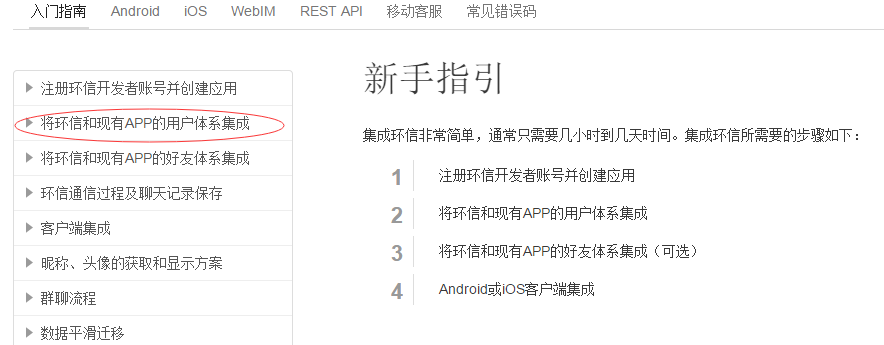編輯:關於Android編程
研究了android從網絡上異步加載圖像,現總結如下:
(1)由於android UI更新支持單一線程原則,所以從網絡上取數據並更新到界面上,為了不阻塞主線程首先可能會想到以下方法。
在主線程中new 一個Handler對象,加載圖像方法如下所示
復制代碼 代碼如下:
private void loadImage(final String url, final int id) {
handler.post(new Runnable() {
public void run() {
Drawable drawable = null;
try {
drawable = Drawable.createFromStream(new URL(url).openStream(), "image.png");
} catch (IOException e) {
}
((ImageView) LazyLoadImageActivity.this.findViewById(id)).setImageDrawable(drawable);
}
});
}
上面這個方法缺點很顯然,經測試,如果要加載多個圖片,這並不能實現異步加載,而是等到所有的圖片都加載完才一起顯示,因為它們都運行在一個線程中。
然後,我們可以簡單改進下,將Handler+Runnable模式改為Handler+Thread+Message模式不就能實現同時開啟多個線程嗎?
(2)在主線程中new 一個Handler對象,代碼如下:
復制代碼 代碼如下:
final Handler handler2=new Handler(){
@Override
public void handleMessage(Message msg) {
((ImageView) LazyLoadImageActivity.this.findViewById(msg.arg1)).setImageDrawable((Drawable)msg.obj);
}
};
對應加載圖像代碼如下:
復制代碼 代碼如下:
//采用handler+Thread模式實現多線程異步加載
private void loadImage2(final String url, final int id) {
Thread thread = new Thread(){
@Override
public void run() {
Drawable drawable = null;
try {
drawable = Drawable.createFromStream(new URL(url).openStream(), "image.png");
} catch (IOException e) {
}
Message message= handler2.obtainMessage() ;
message.arg1 = id;
message.obj = drawable;
handler2.sendMessage(message);
}
};
thread.start();
thread = null;
}
這樣就簡單實現了異步加載了。細想一下,還可以優化的,比如引入線程池、引入緩存等,我們先介紹線程池。
(3)引入ExecutorService接口,於是代碼可以優化如下:
在主線程中加入:private ExecutorService executorService = Executors.newFixedThreadPool(5);
對應加載圖像方法更改如下:
復制代碼 代碼如下:
// 引入線程池來管理多線程
private void loadImage3(final String url, final int id) {
executorService.submit(new Runnable() {
public void run() {
try {
final Drawable drawable = Drawable.createFromStream(new URL(url).openStream(), "image.png");
handler.post(new Runnable() {
public void run() {
((ImageView) LazyLoadImageActivity.this.findViewById(id)).setImageDrawable(drawable);
}
});
} catch (Exception e) {
throw new RuntimeException(e);
}
}
});
}
4)為了更方便使用我們可以將異步加載圖像方法封裝一個類,對外界只暴露一個方法即可,考慮到效率問題我們可以引入內存緩存機制,做法是建立一個HashMap,其鍵(key)為加載圖像url,其值(value)是圖像對象Drawable。先看一下我們封裝的類
復制代碼 代碼如下:
public class AsyncImageLoader3 {
//為了加快速度,在內存中開啟緩存(主要應用於重復圖片較多時,或者同一個圖片要多次被訪問,比如在ListView時來回滾動)
public Map<String, SoftReference<Drawable>> imageCache = new HashMap<String, SoftReference<Drawable>>();
private ExecutorService executorService = Executors.newFixedThreadPool(5); //固定五個線程來執行任務
private final Handler handler=new Handler();
/**
*
* @param imageUrl 圖像url地址
* @param callback 回調接口
* <a href="\"http://www.eoeandroid.com/home.php?mod=space&uid=7300\"" target="\"_blank\"">@return</a> 返回內存中緩存的圖像,第一次加載返回null
*/
public Drawable loadDrawable(final String imageUrl, final ImageCallback callback) {
//如果緩存過就從緩存中取出數據
if (imageCache.containsKey(imageUrl)) {
SoftReference<Drawable> softReference = imageCache.get(imageUrl);
if (softReference.get() != null) {
return softReference.get();
}
}
//緩存中沒有圖像,則從網絡上取出數據,並將取出的數據緩存到內存中
executorService.submit(new Runnable() {
public void run() {
try {
final Drawable drawable = Drawable.createFromStream(new URL(imageUrl).openStream(), "image.png");
imageCache.put(imageUrl, new SoftReference<Drawable>(drawable));
handler.post(new Runnable() {
public void run() {
callback.imageLoaded(drawable);
}
});
} catch (Exception e) {
throw new RuntimeException(e);
}
}
});
return null;
}
//從網絡上取數據方法
protected Drawable loadImageFromUrl(String imageUrl) {
try {
return Drawable.createFromStream(new URL(imageUrl).openStream(), "image.png");
} catch (Exception e) {
throw new RuntimeException(e);
}
}
//對外界開放的回調接口
public interface ImageCallback {
//注意 此方法是用來設置目標對象的圖像資源
public void imageLoaded(Drawable imageDrawable);
}
}
這樣封裝好後使用起來就方便多了。在主線程中首先要引入AsyncImageLoader3 對象,然後直接調用其loadDrawable方法即可,需要注意的是ImageCallback接口的imageLoaded方法是唯一可以把加載的圖 像設置到目標ImageView或其相關的組件上。
在主線程調用代碼:
先實例化對象 private AsyncImageLoader3 asyncImageLoader3 = new AsyncImageLoader3();
調用異步加載方法:
復制代碼 代碼如下:
//引入線程池,並引入內存緩存功能,並對外部調用封裝了接口,簡化調用過程
private void loadImage4(final String url, final int id) {
//如果緩存過就會從緩存中取出圖像,ImageCallback接口中方法也不會被執行
Drawable cacheImage = asyncImageLoader.loadDrawable(url,new AsyncImageLoader.ImageCallback() {
//請參見實現:如果第一次加載url時下面方法會執行
public void imageLoaded(Drawable imageDrawable) {
((ImageView) findViewById(id)).setImageDrawable(imageDrawable);
}
});
if(cacheImage!=null){
((ImageView) findViewById(id)).setImageDrawable(cacheImage);
}
}
5)同理,下面也給出采用Thread+Handler+MessageQueue+內存緩存代碼,原則同(4),只是把線程池換成了Thread+Handler+MessageQueue模式而已。代碼如下:
復制代碼 代碼如下:
public class AsyncImageLoader {
//為了加快速度,加入了緩存(主要應用於重復圖片較多時,或者同一個圖片要多次被訪問,比如在ListView時來回滾動)
private Map<String, SoftReference<Drawable>> imageCache = new HashMap<String, SoftReference<Drawable>>();
/**
*
* @param imageUrl 圖像url地址
* @param callback 回調接口
* @return 返回內存中緩存的圖像,第一次加載返回null
*/
public Drawable loadDrawable(final String imageUrl, final ImageCallback callback) {
//如果緩存過就從緩存中取出數據
if (imageCache.containsKey(imageUrl)) {
SoftReference<Drawable> softReference = imageCache.get(imageUrl);
if (softReference.get() != null) {
return softReference.get();
}
}
final Handler handler = new Handler() {
@Override
public void handleMessage(Message msg) {
callback.imageLoaded((Drawable) msg.obj);
}
};
new Thread() {
public void run() {
Drawable drawable = loadImageFromUrl(imageUrl);
imageCache.put(imageUrl, new SoftReference<Drawable>(drawable));
handler.sendMessage(handler.obtainMessage(0, drawable));
}
}.start();
/*
下面注釋的這段代碼是Handler的一種代替方法
*/
// new AsyncTask() {
// @Override
// protected Drawable doInBackground(Object... objects) {
// Drawable drawable = loadImageFromUrl(imageUrl);
// imageCache.put(imageUrl, new SoftReference<Drawable>(drawable));
// return drawable;
// }
//
// @Override
// protected void onPostExecute(Object o) {
// callback.imageLoaded((Drawable) o);
// }
// }.execute();
return null;
}
protected Drawable loadImageFromUrl(String imageUrl) {
try {
return Drawable.createFromStream(new URL(imageUrl).openStream(), "src");
} catch (Exception e) {
throw new RuntimeException(e);
}
}
//對外界開放的回調接口
public interface ImageCallback {
public void imageLoaded(Drawable imageDrawable);
}
}
至此,異步加載就介紹完了,下面給出的代碼為測試用的完整代碼:
復制代碼 代碼如下:
package com.bshark.supertelphone.activity;
import android.app.Activity;
import android.graphics.drawable.Drawable;
import android.os.Bundle;
import android.os.Handler;
import android.os.Message;
import android.widget.ImageView;
import com.bshark.supertelphone.R;
import com.bshark.supertelphone.ui.adapter.util.AsyncImageLoader;
import com.bshark.supertelphone.ui.adapter.util.AsyncImageLoader3;
import java.io.IOException;
import java.net.URL;
import java.util.concurrent.ExecutorService;
import java.util.concurrent.Executors;
public class LazyLoadImageActivity extends Activity {
final Handler handler=new Handler();
final Handler handler2=new Handler(){
@Override
public void handleMessage(Message msg) {
((ImageView) LazyLoadImageActivity.this.findViewById(msg.arg1)).setImageDrawable((Drawable)msg.obj);
}
};
private ExecutorService executorService = Executors.newFixedThreadPool(5); //固定五個線程來執行任務
private AsyncImageLoader asyncImageLoader = new AsyncImageLoader();
private AsyncImageLoader3 asyncImageLoader3 = new AsyncImageLoader3();
@Override
public void onCreate(Bundle savedInstanceState) {
super.onCreate(savedInstanceState);
setContentView(R.layout.main);
// loadImage("http://www.chinatelecom.com.cn/images/logo_new.gif", R.id.image1);
// loadImage("http://www.baidu.com/img/baidu_logo.gif", R.id.image2);
// loadImage("http://cache.soso.com/30d/img/web/logo.gif", R.id.image3);
// loadImage("http://www.baidu.com/img/baidu_logo.gif", R.id.image4);
// loadImage("http://cache.soso.com/30d/img/web/logo.gif", R.id.image5);
loadImage2("http://www.chinatelecom.com.cn/images/logo_new.gif", R.id.image1);
loadImage2("http://www.baidu.com/img/baidu_logo.gif", R.id.image2);
loadImage2("http://cache.soso.com/30d/img/web/logo.gif", R.id.image3);
loadImage2("http://www.baidu.com/img/baidu_logo.gif", R.id.image4);
loadImage2("http://cache.soso.com/30d/img/web/logo.gif", R.id.image5);
// loadImage3("http://www.chinatelecom.com.cn/images/logo_new.gif", R.id.image1);
// loadImage3("http://www.baidu.com/img/baidu_logo.gif", R.id.image2);
// loadImage3("http://cache.soso.com/30d/img/web/logo.gif", R.id.image3);
// loadImage3("http://www.baidu.com/img/baidu_logo.gif", R.id.image4);
// loadImage3("http://cache.soso.com/30d/img/web/logo.gif", R.id.image5);
// loadImage4("http://www.chinatelecom.com.cn/images/logo_new.gif", R.id.image1);
// loadImage4("http://www.baidu.com/img/baidu_logo.gif", R.id.image2);
// loadImage4("http://cache.soso.com/30d/img/web/logo.gif", R.id.image3);
// loadImage4("http://www.baidu.com/img/baidu_logo.gif", R.id.image4);
// loadImage4("http://cache.soso.com/30d/img/web/logo.gif", R.id.image5);
// loadImage5("http://www.chinatelecom.com.cn/images/logo_new.gif", R.id.image1);
// //為了測試緩存而模擬的網絡延時
// SystemClock.sleep(2000);
// loadImage5("http://www.baidu.com/img/baidu_logo.gif", R.id.image2);
// SystemClock.sleep(2000);
// loadImage5("http://cache.soso.com/30d/img/web/logo.gif", R.id.image3);
// SystemClock.sleep(2000);
// loadImage5("http://www.baidu.com/img/baidu_logo.gif", R.id.image4);
// SystemClock.sleep(2000);
// loadImage5("http://cache.soso.com/30d/img/web/logo.gif", R.id.image5);
// SystemClock.sleep(2000);
// loadImage5("http://www.baidu.com/img/baidu_logo.gif", R.id.image4);
}
@Override
protected void onDestroy() {
executorService.shutdown();
super.onDestroy();
}
//線程加載圖像基本原理
private void loadImage(final String url, final int id) {
handler.post(new Runnable() {
public void run() {
Drawable drawable = null;
try {
drawable = Drawable.createFromStream(new URL(url).openStream(), "image.png");
} catch (IOException e) {
}
((ImageView) LazyLoadImageActivity.this.findViewById(id)).setImageDrawable(drawable);
}
});
}
//采用handler+Thread模式實現多線程異步加載
private void loadImage2(final String url, final int id) {
Thread thread = new Thread(){
@Override
public void run() {
Drawable drawable = null;
try {
drawable = Drawable.createFromStream(new URL(url).openStream(), "image.png");
} catch (IOException e) {
}
Message message= handler2.obtainMessage() ;
message.arg1 = id;
message.obj = drawable;
handler2.sendMessage(message);
}
};
thread.start();
thread = null;
}
// 引入線程池來管理多線程
private void loadImage3(final String url, final int id) {
executorService.submit(new Runnable() {
public void run() {
try {
final Drawable drawable = Drawable.createFromStream(new URL(url).openStream(), "image.png");
handler.post(new Runnable() {
public void run() {
((ImageView) LazyLoadImageActivity.this.findViewById(id)).setImageDrawable(drawable);
}
});
} catch (Exception e) {
throw new RuntimeException(e);
}
}
});
}
//引入線程池,並引入內存緩存功能,並對外部調用封裝了接口,簡化調用過程
private void loadImage4(final String url, final int id) {
//如果緩存過就會從緩存中取出圖像,ImageCallback接口中方法也不會被執行
Drawable cacheImage = asyncImageLoader.loadDrawable(url,new AsyncImageLoader.ImageCallback() {
//請參見實現:如果第一次加載url時下面方法會執行
public void imageLoaded(Drawable imageDrawable) {
((ImageView) findViewById(id)).setImageDrawable(imageDrawable);
}
});
if(cacheImage!=null){
((ImageView) findViewById(id)).setImageDrawable(cacheImage);
}
}
//采用Handler+Thread+封裝外部接口
private void loadImage5(final String url, final int id) {
//如果緩存過就會從緩存中取出圖像,ImageCallback接口中方法也不會被執行
Drawable cacheImage = asyncImageLoader3.loadDrawable(url,new AsyncImageLoader3.ImageCallback() {
//請參見實現:如果第一次加載url時下面方法會執行
public void imageLoaded(Drawable imageDrawable) {
((ImageView) findViewById(id)).setImageDrawable(imageDrawable);
}
});
if(cacheImage!=null){
((ImageView) findViewById(id)).setImageDrawable(cacheImage);
}
}
}
xml文件大致如下:
復制代碼 代碼如下:
<SPAN ><STRONG>< ?xml version="1.0" encoding="utf-8"?>
< LinearLayout xmlns:android="http://schemas.android.com/apk/res/android"
android:layout_width="fill_parent"
android:orientation="vertical"
android:layout_height="fill_parent" >
<ImageView android:id="@+id/image1" android:layout_height="wrap_content" android:layout_width="fill_parent"></ImageView>
<ImageView android:id="@+id/image2" android:layout_height="wrap_content" android:layout_width="fill_parent"></ImageView>
<ImageView android:id="@+id/image3" android:layout_height="wrap_content" android:layout_width="fill_parent"></ImageView>
<ImageView android:id="@+id/image5" android:layout_height="wrap_content" android:layout_width="fill_parent"></ImageView>
<ImageView android:id="@+id/image4" android:layout_height="wrap_content" android:layout_width="fill_parent"></ImageView>
< /LinearLayout></STRONG></SPAN>
 Android4.2.2 CameraService服務啟動和應用端camera初始化記錄
Android4.2.2 CameraService服務啟動和應用端camera初始化記錄
之前的10篇博文主要是記錄了Android4.2.2的SurfaceFlinger的相關內容,為何之前會投入那麼多的時間,原因就在於之前在看camera的架構時,遇到了本
 android-使用環信SDK開發即時通信功能(附源碼下載)
android-使用環信SDK開發即時通信功能(附源碼下載)
最近項目中集成即時聊天功能,挑來揀去,最終選擇環信SDK來進行開發,選擇環信的主要原因是接口方便、簡潔,說明文檔清晰易懂。文檔有Android、iOS、和後台服務器端,還
 Universal-Image-Loader,android-Volley,Picasso、Fresco和Glide圖片緩存庫的聯系與區別
Universal-Image-Loader,android-Volley,Picasso、Fresco和Glide圖片緩存庫的聯系與區別
前言Universal-Image-Loader,android-Volley,Picasso、Fresco和Glide五大Android開源組件加載網絡圖片比較。在An
 Android:使用ZXing生成二維碼(支持添加Logo圖案)
Android:使用ZXing生成二維碼(支持添加Logo圖案)
ZXing是谷歌的一個開源庫,可以用來生成二維碼、掃描二維碼。本文所介紹的是第一部分。首先上效果圖:ZXing相關各種文件官方下載地址:https://github.co